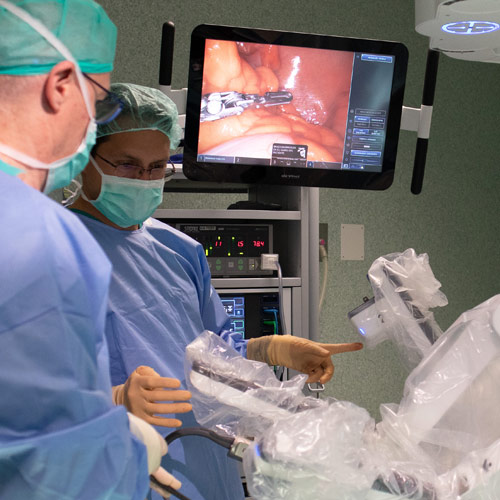Minimally Invasive Surgery UnitUro-Oncology Unit
Home » Uro-Oncology » Minimally Invasive Surgery Unit

Minimally invasive surgery comprises a set of surgical approaches that minimise or avoid incisions in the patient’s skin, and that are necessary with open or conventional surgery. This reduces postoperative pain, bleeding risk, infection risk and the hospital stay, while achieving better cosmetic results, and the patient can resume normal every day activities earlier.
To carry out this type of surgery, monitors, computers, optical devices and other materials specific to each surgery are necessary. The constant technological development has led to the proliferation and permanent modernisation of the material used.
Following our philosophy, we have incorporated all these options to our therapeutic arsenal, and we are continuously looking for and acquiring the newest equipment in order to offer them to the patients that we believe may benefit from it.
Laparoscopic surgery
It consists of introducing the surgical equipment into the abdomen through small skin incisions (between 5 and 10 mm). To carry it out, the following are required: a rod lens system, which is inserted into the patient’s abdomen, connected to a screen, and a CO2 insufflator to distend the abdomen, separate the different organs and make room for surgical manoeuvres.
In our Unit we conduct all urological surgeries included in this approach:
- Laparoscopic radical prostatectomy.
- Laparoscopic radical nephrectomy.
- Partial laparoscopic nephrectomy.
- Laparoscopic radical cystectomy.
- Laparoscopic colposacropexy.
- Laparoscopic adenomectomy.
- Laparoscopic adrenalectomy.
- Laparoscopic lymphadenectomy.
Our unit has accredited surgeons and experts in robotic and laparoscopic surgery.
Robotic surgery
Robotic surgery represents a revolution. It consists of the use of a robot that has arms, to which the necessary equipment is attached, and a rod lens system that is introduced into the patient through minimal incisions.The robot is controlled by a surgeon operating from a console. It offers a 3D view to the surgeon that handles the camera, provides a greater degree of motility, eliminates trembling, gives an ergonomic position, among other functions.
To sum up, it improves the vision, as well as the precision and the skill control of the surgeon. The robot was initially developed to allow surgeons to operate wounded American soldiers that were thousands of miles away. Robotic surgery is currently used in all developed countries. The number of procedures increases every day (for example, in the USA, laparoscopic surgery is incredibly favouring robotic surgery).
Our unit has accredited surgeons and experts in robotic surgery to perform the same procedures as with laparoscopic surgery.

